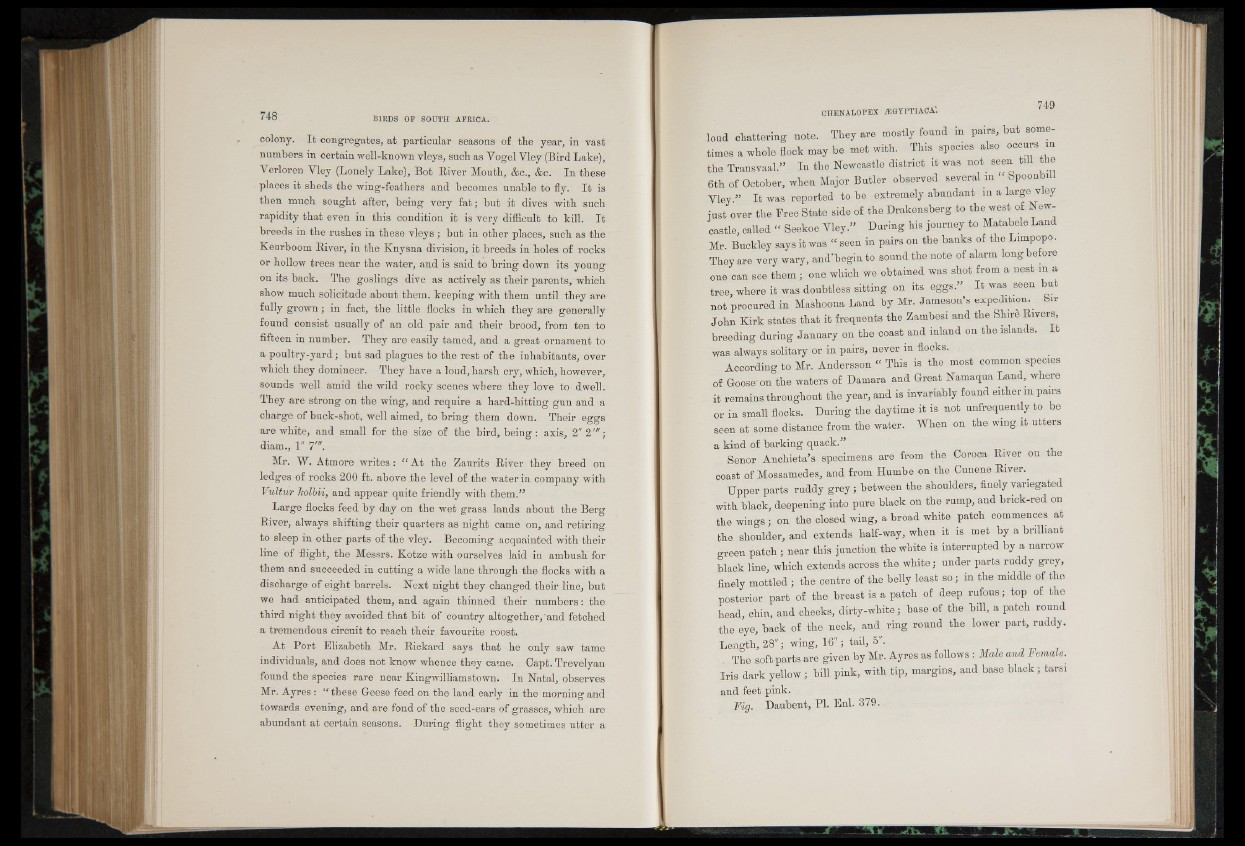
colony. It congregates, at particular seasons of the year, in vast
numbers in certain well-known vleys, such as Yogel Vley (Bird Lake),
Yerloren Yley (Lonely Lake), Bot River Mouth, &c., &c. In these
places it sheds the wing-feathers and becomes unable to fly. It is
then much sought after, being very fat; but it dives with such
rapidity that even in this condition it is very difficult to kill. It
breeds in the rushes in these vleys; but in other places, such as the
Keurboom River, in the Knysna division, it breeds in holes of rocks
or hollow trees near the water, and is said to bring down its young
on its back. The goslings dive as actively as their parents, which
show much solicitude about them, keeping with them until they are
grown; in fact, the little flocks in which they are generally
found consist usually of an old pair and their brood, from ten to
fifteen in number. They are easily tamed, and a great ornament to
a poultry-yard; but sad plagues to the rest of the inhabitants, over
which they domineer. They have a loud, harsh cry, which, however,
sounds well amid the wild rocky scenes where they love to dwell.
They are strong on the wing, and require a hard-hitting gun and a
charge ot buck-shot, well aimed, to bring them down. Their eggs
are white, and small for the size of the bird, being: axis, 2" 2'";
diam., 1" 7'".
Mr. W. Atmore writes : “ At the Zaurits River they breed on
ledges of rocks 200 ft. above the level of the water in company with
Vultur Jcolbii, and appear quite friendly with them.”
Large flocks feed by day on the wet grass lands about the Berg
River, always shifting their quarters as night came on, and retiring
to sleep in other parts of the vley. Becoming acquainted with their
line of flight, the Messrs. Kotze with ourselves laid iu ambush for
them and succeeded in cutting a wide lane through the flocks with a
discharge of eight barrels. Next night they changed their line, but
we had anticipated them, and again thinned their numbers: the
third night they avoided that bit of country altogether/and fetched
a tremendous circuit to reach their favourite roost.
At Port Elizabeth Mr. Rickard says that he only saw tame
individuals, and does not know whence they came. Capt. Trevelyan
found the species rare near Kingwilliamstown. In Natal, observes
Mr. Ayres : “ these Geese feed on the land early in the morning and
towards evening, and are fond of the seed-ears of grasses, which are
abundant at certain seasons. During flight they sometimes utter a
loud chattering note. They are mostly found m pairs, but sometimes
a whole flock may be met with. This species also occurs in
the Transvaal.” In the Newcastle district it was not seen till the
6th of October, when Major Butler observed several m “ Spoonbill
Yley.” It was reported to be extremely abundant m a large vley
just over the Free State side of the Drakensberg to the west of Newcastle,
called I Seekoe Yley.” During his journey to Matabele Land
Mr. Buckley says it was “ seen in pairs on the banks of the Limpopo.
They are very wary, and*begin to sound the note of alarm long before
one can see them; one which we obtained was shot from a nest in a
tree, where it was doubtless sitting on its eggs.” It was seen but
not procured in Mashoona Land by Mr. Jameson’s expedition. Sir
John Kirk states that it frequents the Zambesi and the Shire Rivers,
breeding during January on the coast and inland on the islands. It
was always solitary or in pairs, never in flocks.
According to Mr. Andersson “ This is the most common species
of Goose'on the waters of Damara and Great Namaqua Land, where
it remains throughout the year, and is invariably found either m pairs
or in small flocks. During the daytime it is not unfrequently to be
seen at some distance from the water. When on the wing it utters
a kind of barking quack.”
Senor Anchieta’s specimens are from the Coroca River on the
coast of Mossamedes, and from Humbe on the Cunene River.
Upper parts ruddy grey; between the shoulders, finely variegated
with black, deepening into pure black on the rump, and brick-red on
the wings; on the closed wing, a broad white patch commences at
the shoulder, and extends half-way, when it is met by a brilliant
green patch ; near this junction the white is interrupted by a narrow
black line, which extends across the white; under parts ruddy grey,
finely mottled; the centre of the belly least so; m the middle of the
posterior part of the breast is a patch of deep rufous; top of the
head, chin, and cheeks, dirty-white; base of the bill, a patch round
the eye, back of the neck, and ring round the lower part, ruddy.
Length, 28"; wing, 16"; tail, 5". ?
. The soft parts are given by Mr. Ayres as follows : Male and Female.
Iris dark yellow ; bill pink, with tip, margins, and base black; tarsi
and feet pink.
Fig. Daubent, PI. Enl. 379.